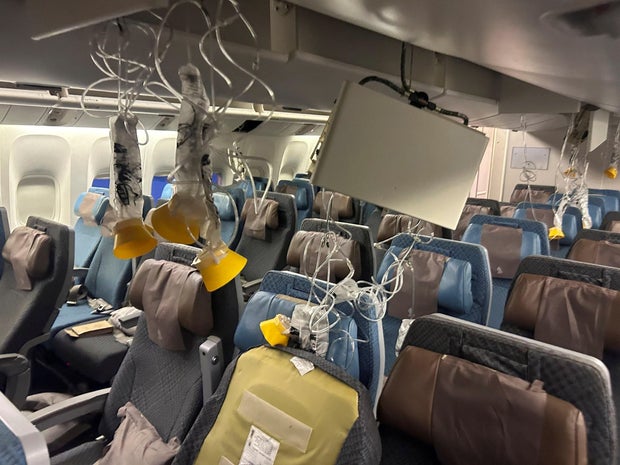According to Singapore Airlines, the aircraft traveling from London to Singapore encountered “sudden extreme turbulence” on Tuesday, resulting in the death of one individual and the injury of dozens of others. Flight SQ321 from London’s Heathrow Airport was diverted to Bangkok and touched down at 3:45 p.m. local time Tuesday at Suvarnabhumi Airport, the carrier said in a statement posted to its Facebook page.
“We can confirm that there are injuries and one fatality on board the Boeing 777-300ER,” an earlier statement said, adding that there were 211 passengers and 18 crew members on the plane.
According to officials, the deceased passenger was a British male aged 73. At a news conference, Kittipong Kittikachorn, the director of Suvarnabhumi Airport, disclosed that seven individuals sustained critical injuries, including several with head injuries, and that numerous others sustained injuries of variable severity.
News agencies reported that Bangkok’s Samitivej Srinakarin Hospital treated a total of 71 individuals, six of whom sustained grievous injuries.
As passengers descended a ramp onto the tarmac from the Thai airport, there were emergency vehicles surrounding the plane. Video footage captured the event.
Several individuals were observed lying on a tarp beneath a tent in a triage area that was overcrowded with medical and airport personnel.
The airline extended its “heartfelt condolences” to the family of the deceased and announced that it was offering assistance to all passengers and crew members on the flight.
Boeing also offered condolences to the family of the passenger who died in a statement posted on social media. The U.S. aerospace behemoth stated that it was in communication with Singapore Airlines and prepared to provide assistance as the carrier investigated the incident.
Tracking data from the FlightAware website showed the Singapore Airlines plane dropping suddenly from an altitude of about 37,000 feet to 31,000 feet in the space of only about five minutes. About 10 hours into the flight from London, the Boeing 777 completed its crossing of the Andaman Sea and was approaching the Thai coast when the plummet occurred. Thunderstorms were observed in the vicinity.
Dzafran Azmir, a passenger, reported to the Reuters news agency that the aircraft abruptly began to tilt upward and there was a noticeable amount of shaking. As a result, he began to prepare for his imminent descent. Suddenly, there was a dramatic drop, causing all passengers who were not wearing seatbelts to be abruptly propelled into the ceiling. “The impact of some people’s heads dented the baggage compartments above.” They struck the locations where masks and lamps are located and penetrated them directly.
“It was an awful experience,” he stated. “A significant number of individuals sustained injuries, including the air stewards, who remained composed and exerted themselves to the fullest.”
Davies stated that the aircraft plummeted with “very little warning,” but the seatbelt warning light had illuminated.
He described the chaos in the cabin, where passengers with medical training attempted to assist the injured and people called for a defibrillator. “I immediately fastened my seatbelt,” he said, “and then the plane just plummeted.”
Davies stated in a tweet that “one of the Singapore Airlines crew members stated that it was the most traumatic experience she had experienced in her 30 years of flying.” She also mentioned that the lesson to be learned is to always wear a seatbelt. Any person who suffered an injury did not use a seatbelt.
The airline reported that four Americans were aboard the flight. The remaining passengers were from the following countries: 56 from Australia, 47 from the U.K., 41 from Singapore, 23 from New Zealand, 16 from Malaysia, five from the Philippines, four from Ireland, three from India, two each from Canada, Indonesia, Myanmar, and Spain, and one each from Germany, Iceland, Israel, and South Korea.
Although in-flight turbulence is becoming more prevalent on numerous routes, fatalities and severe injuries are exceedingly uncommon. In July 2023, severe turbulence on a domestic U.S. flight in Florida injured four people.
He described the situation as an “in-flight upset” at this time, with the caveat that it is too early to determine whether it is the consequence of atmospheric turbulence or something else.
Although the causes of this incident are not yet clear, climatologists have warned travelers to brace for more flight delays and cancellations and more frequent and more severe turbulence, especially on routes over the world’s fast-warming oceans, as a result of climate change.
According to Tracy Wholf, a climate producer for CBS News, the effects of climate change on air travel go far beyond just increasing turbulence. Airports are also suffering from worsened flooding, extreme heat and precipitation that makes takeoffs and landings difficult, and even an increase in midair lightning strikes.


